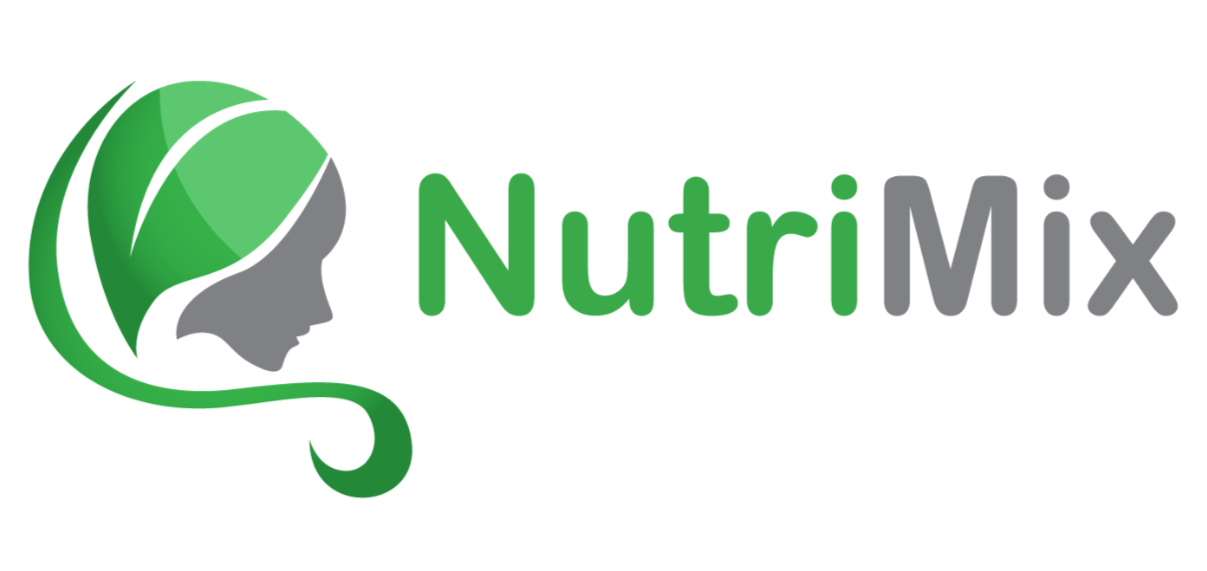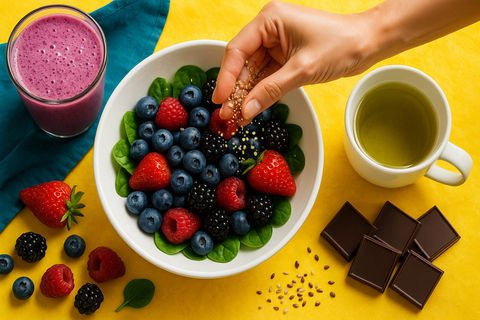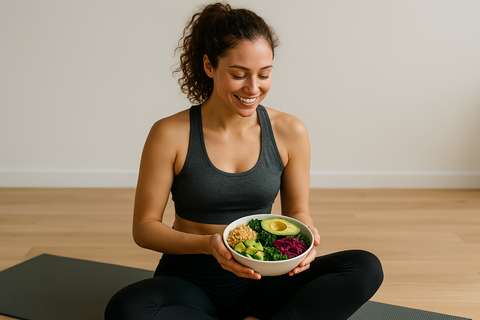Aging isn’t just about wrinkles or gray hair—it’s the cumulative result of microscopic wear and tear in every cell of your body. Central to this process are free radicals, unstable molecules that damage DNA, proteins, and cell membranes through oxidative stress. Left unchecked, this oxidative damage contributes to inflammation, chronic disease, and the visible signs of aging.
Fortunately, nature supplies us with a potent defense: polyphenols, a diverse family of plant‑derived compounds renowned for their antioxidant and anti‑inflammatory activities. Found in colorful fruits, tea, chocolate, spices, and even nuts, polyphenols can neutralize free radicals, modulate gene expression, and support key physiological processes. This comprehensive guide will dive into:
-
What polyphenols are and how they work
-
Detailed health benefits (beyond the basics)
-
The most polyphenol‑rich foods, with a handy reference table
-
Optimizing absorption, dosing guidelines, and safety
-
Eight in‑depth recipes & daily strategies
1. Polyphenols 101: Structure, Classes & Mechanisms
Polyphenols share a basic chemical feature—multiple phenol rings—but fall into four major classes, each with unique activities:
| Class | Key Compounds | Common Food Sources | Primary Actions |
|---|---|---|---|
| Flavonoids | Quercetin, Anthocyanins, EGCG | Berries, onions, kale, green tea | Antioxidant, anti‑inflammatory, vascular |
| Phenolic Acids | Chlorogenic acid, Caffeic acid | Coffee, whole grains, berries | Antioxidant, glucose‑regulating |
| Stilbenes | Resveratrol | Red grapes, red wine, peanuts | Sirtuin‑activating, endothelial protection |
| Lignans | Secoisolariciresinol | Flaxseeds, sesame seeds, whole grains | Phytoestrogenic, antioxidant, gut health |
How They Work, Step by Step
-
Free Radical Scavenging: donate electrons to neutralize ROS (e.g., superoxide, hydroxyl radicals)
-
Enzyme Modulation: inhibit pro‑inflammatory enzymes (COX‑2, 5‑LOX)
-
Signal Transduction: downregulate NF‑κB and MAPK pathways, reducing cytokine release
-
Gene Expression: activate Nrf2, enhancing the body’s endogenous antioxidant defenses (e.g., glutathione production)
-
Microbiome Interplay: gut bacteria metabolize polyphenols into bioactive metabolites, which can have systemic effects
2. Deep‑Dive Benefits

2.1 Cellular & Mitochondrial Protection
-
Mitochondrial Health: Polyphenols like quercetin and resveratrol enhance mitochondrial biogenesis via PGC‑1α activation, improving energy production and reducing age‑related decline.
-
DNA Repair: Epigallocatechin gallate (EGCG) has been shown to upregulate DNA repair enzymes (e.g., PARP), helping cells recover from oxidative lesions.
2.2 Cardiovascular Resilience
-
Endothelial Function: Flavanols in cocoa and tea increase nitric oxide (NO) bioavailability, promoting vasodilation and healthy blood pressure.
-
Cholesterol Management: Chlorogenic acid helps reduce LDL oxidation and improves HDL‑to‑LDL ratio.
2.3 Cognitive Vitality
-
Neuroprotection: Resveratrol and berry anthocyanins cross the blood‑brain barrier, attenuating neuroinflammation and supporting synaptic plasticity.
-
Blood–Brain Barrier Integrity: Polyphenols upregulate tight‑junction proteins (occludin, claudin‑5), helping prevent “leaky” barrier and neurotoxic insults.
2.4 Skin & Connective Tissue
-
Collagen Maintenance: Curcumin and procyanidins boost collagen type I synthesis in dermal fibroblasts, improving skin elasticity and reducing wrinkle depth.
-
UV Protection: Topical and dietary polyphenols absorb UVB and scavenge UV‑induced ROS, minimizing photoaging.
2.5 Gut Health & Immunity
-
Prebiotic Effects: Polyphenol metabolites feed beneficial microbes like Akkermansia and Bifidobacterium, which produce short‑chain fatty acids (SCFAs) that support gut barrier integrity.
-
Immune Modulation: EGCG and resveratrol modulate T‑cell activity and cytokine profiles, helping balance immune responses.
3. Food Sources & Daily Targets
Aim for 500–1,000 mg of total polyphenols per day (roughly the amount found in a diet rich in fruits, vegetables, tea, and whole grains). Use the table above as a quick reference, and consider these practical servings:
-
Green Tea: 2–3 cups (200–300 mg EGCG)
-
Berries: 1 cup mixed (200–300 mg anthocyanins)
-
Dark Chocolate (70%+): 1 oz (100–150 mg flavanols)
-
Coffee: 1 cup (70–200 mg chlorogenic acids)
-
Turmeric: 1 tsp fresh or powdered (>50 mg curcuminoids)
Tip: Variety is key—rotate sources to tap into different polyphenolic profiles.

4. Maximizing Absorption & Safety

4.1 Bioavailability Boosters
-
Pair with Fats: Many polyphenols are fat‑soluble. Add nuts, seeds, avocado, or olive oil to meals.
-
Vitamin C Synergy: Ascorbic acid stabilizes anthocyanins and flavanols—try berries with a squeeze of lemon.
-
Gentle Preparation: Avoid prolonged high‑heat cooking of spices and herbs; add them near the end of cooking or use fresh.
4.2 Supplement Considerations
-
Standardized Extracts: If choosing supplements, look for EGCG (green tea), curcumin with piperine (black pepper) for improved absorption, or resveratrol in micronized form.
-
Dosage Caution: High‑dose extracts can interact with medications (e.g., blood thinners). Always consult a healthcare provider before starting.
4.3 Potential Interactions & Contraindications
-
Blood Thinners: Polyphenol‑rich extracts may potentiate anticoagulants.
-
Iron Absorption: Phenolic acids can inhibit non‑heme iron uptake; take iron supplements 2 hours apart.
-
Thyroid Disorders: High green tea intake can affect thyroid hormone levels in sensitive individuals.
5. Eight In‑Depth Recipes & Daily Strategies
5.1 Morning
-
Polyphenol Power Overnight Oats

-
Ingredients: ½ cup oats, 1 Tbsp chia seeds, 1 cup unsweetened almond milk, ¼ cup mixed berries, 1 tsp matcha powder.
-
Method: Combine oats, chia, milk, and matcha; refrigerate overnight. Top with berries in the morning.
-
Why It Works: Slow‑release carbs plus matcha EGCG and berry anthocyanins jump‑start antioxidant defenses.
2. Turmeric‑Ginger Green Smoothie

-
Ingredients: 1 cup spinach, ½ banana, 1 tsp turmeric, ½ tsp fresh ginger, 1 Tbsp flaxseed, 1 cup green tea (cooled).
-
Method: Blend until smooth.
-
Why It Works: Curcuminoids and flavonoids combine with healthy fats to improve bioavailability.
5.2 Midday
3. Rainbow Quinoa Salad

-
Ingredients: 1 cup cooked quinoa, ½ cup diced red cabbage, ½ cup diced cucumber, ¼ cup pomegranate arils, 2 Tbsp chopped walnuts, dressing of olive oil + lemon juice.
-
Method: Toss ingredients; drizzle dressing.
-
Why It Works: Phenolic acids from quinoa, punicalagins from pomegranate, and flavanols from walnuts deliver a diverse polyphenol matrix.
4. Berry‑Infused Iced Green Tea

-
Ingredients: Brewed green tea, handful of raspberries, lemon slices, ice.
-
Method: Muddle berries lightly, steep tea over ice for 2 min.
-
Why It Works: Cold‑brew preserves delicate catechins and anthocyanins.
5.3 Afternoon Snack
5. Dark Chocolate & Nut Butter “Energy Bites”

-
Ingredients: ½ cup oats, 2 Tbsp peanut butter, 1 Tbsp cocoa powder, 1 Tbsp honey, dash of cinnamon, 1 Tbsp chopped dark chocolate (70%+).
-
Method: Mix into balls; chill 30 min.
-
Why It Works: Concentrated flavanols + fiber slow sugar release.
5.4 Evening
6. Resveratrol‑Rich Grilled Salmon

-
Ingredients: Salmon fillet, marinade of red wine vinegar, garlic, rosemary, black pepper.
-
Method: Marinate 30 min; grill until flaky.
-
Why It Works: Stilbene boost from the vinegar and herbs complements omega‑3 benefits.
8. Warm Turmeric‑Coconut Milk Elixir

-
Ingredients: 1 cup coconut milk, 1 tsp turmeric, pinch black pepper, ½ tsp cinnamon, honey to taste.
-
Method: Gently heat ingredients; whisk until frothy.
-
Why It Works: Piperine from black pepper enhances curcumin absorption by up to 2,000%.
Conclusion & Action Steps
Polyphenols are among the most versatile, science‑backed nutrients you can introduce to your diet. They not only neutralize damaging free radicals but also tune cellular signaling, fuel mitochondrial health, and promote a balanced microbiome. By aiming for 500–1,000 mg daily through whole foods, strategic meal pairings, and, if desired, targeted supplements, you’ll forge a robust defense against aging and chronic disease.
Next Steps:
-
Choose one new polyphenol source each week (e.g., pomegranates, matcha, or turmeric).
-
Share your progress: Snap your colorful meals on Instagram with #NutriMixPolyphenols
Embrace the power of plants—your cells will thank you with every glowing day ahead.



